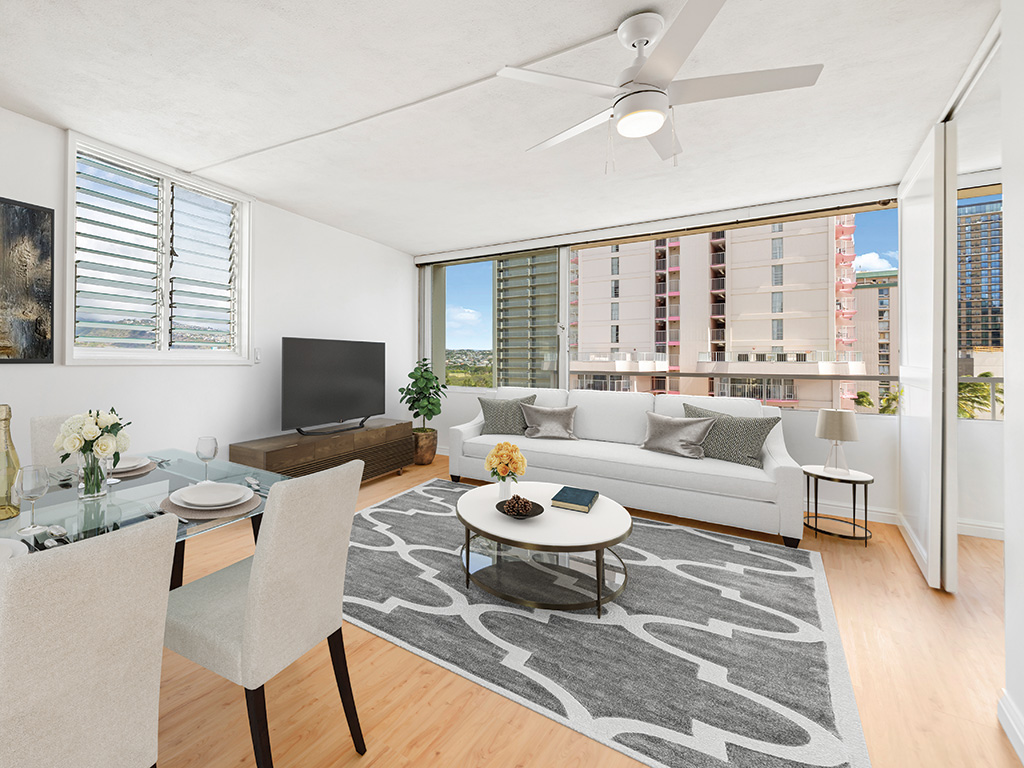Home Staging Blends Art and Science
This valuable service can make a big difference when selling your property.

Home staging, which has been around for roughly five decades, is a creative approach to real estate that can pay big dividends for those looking for a quick property sale.
Brandon Kim, a real estate agent at List Sotheby’s International Realty, explains that home staging is “taking a vacant property, or maybe even a property that’s already occupied or lived in, and basically setting the stage for the buyer to where they can envision the use of the space.”
For occupied properties, staging could entail decluttering, rearranging furniture, deep cleaning and adding accent pieces. A vacant home, says Kim, requires an experienced stager who “will know how to treat the property, and what to put in it.
“If it’s a really big luxury property, then you have to go to a stager that’s going to have big furniture that will fill that property up to scale,” he shares. “In a condo, you have to use smaller furniture than you would in a big Kahala home.”
Staging sets the tone for warm walk-throughs and can make for attractive photos for online listings. “The more people you get into the property, the better chance of your selling it,” shares Kim.
Among the home stagers who Kim works with are husband and wife team Hiram and Lisa Robles of Dream Décor. They offer insights here.

A living room before renovation. Below is the same living room after it was remodeled and staged. Photos: Courtesy of Dream Décor

What are the benefits of staging?
Lisa Robles says a home that isn’t staged can have zero offers — but bring in a stager, and things change fast. “We’ve taken properties that have been on the market for two months, and we went in and staged — and boom! In a week it’s in escrow,” she says.
According to Hiram Robles, “it’s all about first impressions.” Most buyers walk into a property and “make up their mind within the first like 10-20 seconds. If they don’t get a good impression from the start, then the rest of the walk-through doesn’t go as well. But if you get them at the beginning, then they’re already [thinking about] buying the place.”


What should you look for in a stager?
As a real estate agent, Kim says he prefers to work with stagers who have a large inventory of furnishings and accessories. He also checks out project photos and considers how easy they are to work with, from setup to de-staging.
Home stagers don’t have an industry licensing program, but Hiram and Lisa Robles say certification programs help keep them in the know on trends and best practices. Professional home stagers can also share new ideas with their peers, and receive them as well, through various organizations. Lisa Robles says it’s important to make sure that the home staging service you select has proper credentials, insurance and local business licensing.

Photo: Courtesy of Dream Décor
What is the general process like for home staging?
Hiram Robles says staging starts with creating an experience where the home “feels like it’s lived in, but doesn’t feel like it belongs to anybody.” Unlike interior design, which is catered to specific tastes, he says home staging is “depersonalized” and set up to attract the largest number of people.
Dream Décor works closely with Realtors to understand the walk-through routes in homes. Depending on points of entry and focus, the stagers will spend more time with furnishings and décor in key areas like the living room and kitchen. Some people choose to have their second-floor rooms staged as well.
After a home is sold, Dream Décor removes the staged furniture and accessories.

Photo: Courtesy of Dream Décor
Why did you get into home staging?
Dream Décor started out as an unexpected business for the couple. When they were in the market to sell their Waianae home — which they built from the ground up — their Realtor was impressed with how they had set up the home for viewing.
Hiram Robles is an engineer, and Lisa Robles at the time was working at the Waianae Coast Comprehensive Health Center. They decided to go all-in with a home staging enterprise, and in seven years Dream Décor has grown from 15 jobs in its first year into a business with 250 to 300 staging projects a year.
“I think for me and Hiram it’s a passion, and we just love to do it,” says Lisa Robles.
Editor’s Note: This article has been slightly modified from the original print version for optimal online reading. To view the full print story, subscribe to our digital edition or pick up your copy of Hawaii Home + Remodeling at one of our partner locations.





